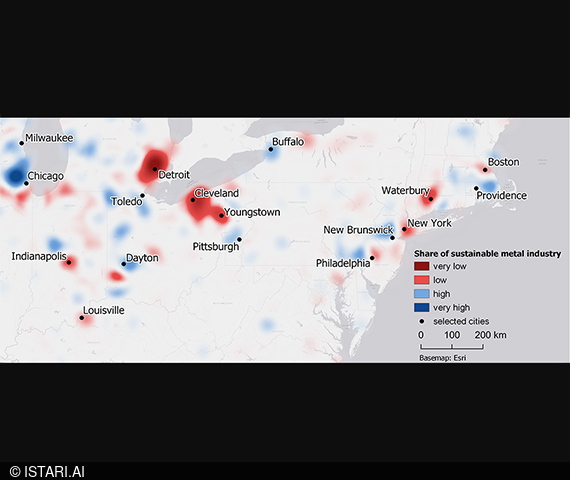No Systematic Greenwashing in the US Metals Industry
ResearchDo metal processing companies in the USA make themselves appear more eco-friendly in terms of their sulphur dioxide emissions than they actually are? To investigate this, a team of researchers in collaboration with ZEW has applied a new method that combines satellite data with company data and web text mining.
The subject of sustainability has gained great importance in recent years, especially with regard to the emission of harmful substances and the associated air pollution. One of the most harmful pollutants is sulphur dioxide (SO2). The gas is a leading ingredient in the formation of particulate matter and acid rain. Among other things, it is released by production processes in the metal industry, which is one of the largest sources of emissions worldwide.
Greenwashing: eco-friendly image, but no measures
Social pressure and the benefits that come with an eco-friendly image are prompting many companies to present themselves as particularly sustainable. Sometimes this leads to what is known as greenwashing, i.e. a company projects a sustainable image that differs greatly from its actual environmental impact. When greenwashing, companies thus portray themselves as eco-friendly without implementing effective and often costly measures.
However, greenwashing is often hard to detect. ISTARI.AI – a start-up that uses artificial intelligence to provide web-based economic data in real time – has developed an innovative method in cooperation with researchers from ZEW and the universities of Salzburg, Heidelberg, Giessen and Harvard. The researchers analysed the self-portrayal of companies based on their websites using web text mining, and combined the data obtained with available global pollutant data from the Sentinel-5 Precursor satellite and company data from Harvard University (“Infogroup US Historical Business Data”).
Around eight per cent of the US metals industry operates sustainably
ISTARI.AI uses webAI to scan company websites, analyse and recognise relevant information using artificial intelligence and make the data available in real time. In this way, the research team examined the websites of 9,430 companies from the US metals industry. According to their self-portrayal, the companies were categorised as sustainable and non-sustainable. A total of 760 companies in the US metals industry were classified as sustainable (8.1 per cent) and 4,821 companies (51.3 per cent) as non-sustainable. A further 3,822 companies (40.6 per cent) did not have their own website and were therefore not assessed by webAI.
The map shows an example of the distribution of sustainable and non-sustainable metal industries in the north-east of the USA. There is a clear concentration of sustainable companies, especially in the north of Chicago, but also in Dayton, Pittsburgh and Buffalo, for example.
The comparison with the satellite data shows that the metal processing companies that are sustainable according to their self-portrayal actually have a lower impact on local SO2 concentrations than the non-sustainable companies. Consequently, there is no evidence of systematic greenwashing in the US metals industry. However, this is true for the industry as a whole and not for individual companies; greenwashing probably occurs in individual cases. Furthermore, the results should be interpreted with caution, as two-fifths of the companies considered did not have their own website and thus could not be included in the study.

